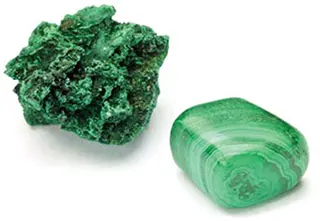
Exploring the Origins
Malachite, characterized by its rich green color and banded appearance, is a copper carbonate mineral. The name likely stems from its resemblance to mallow plant leaves. Commonly found, malachite deposits are located in Zambia, the Democratic Republic of the Congo, Romania, Russia, and the Middle East.
Historical Significance and Lore
Historically favored by the ancient Egyptians, malachite was used both as jewelry and, when pulverized, as eye shadow—a practice also adopted by the Greeks and Romans. In the Middle Ages, it was believed to protect against the “evil eye” and cure stomach ailments. Although once a popular pigment in painting, its use has declined due to toxicity concerns with the powdered form.
Healing Properties
Malachite should be used cautiously, preferably under expert guidance, due to its potential toxicity. It is effective in easing menstrual and childbirth pain, reducing joint and muscle inflammation, treating asthma, lowering blood pressure, and boosting the immune system. It should always be used in its polished form.
Magical Uses
This green stone is known for amplifying positive energy and balancing the heart chakra. It can be used in scrying or to access other realms, with placement on the third eye enhancing psychic vision.
Feng Shui Applications
In Feng Shui, malachite is valued for its ability to absorb negative energy and pollutants. It should be cleansed regularly, ideally with a quartz cluster in sunlight. Malachite’s wood energy makes it effective in the eastern and southeastern areas of a space.
Personal and Spiritual Growth
Malachite is a stone of transformation and change, encouraging risk-taking and emotional healing. Placing it on the solar plexus can help absorb negative emotions, while on the heart, it fosters balance, harmony, and unconditional love.
